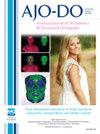Exploring etiologic contributions to the occurrence of external apical root resorption
IF 2.7
2区 医学
Q1 DENTISTRY, ORAL SURGERY & MEDICINE
American Journal of Orthodontics and Dentofacial Orthopedics
Pub Date : 2024-10-01
DOI:10.1016/j.ajodo.2024.05.017
引用次数: 0
Abstract
Introduction
External apical root resorption (EARR) is often an undesirable sequela of orthodontic treatment. Prior studies have suggested a substantial link between EARR and certain genetic components. Single nucleotide polymorphisms (SNPs) may play a role as predisposing factors. This study aimed to investigate the potential association between EARR and various SNPs.
Methods
The study included 218 orthodontic participants of all malocclusions who had available pretreatment and posttreatment panoramic radiographs. The most severely affected maxillary incisor on the radiograph was assessed for EARR using a 0-4 categorical scale. DNA was taken from the saliva samples of the participants, and the SNPs were analyzed using polymerase chain reaction and TaqMan chemistry. Statistical testing was performed to verify any associations with EARR (P <0.05).
Results
From all genes tested, the rs678397 SNP of ACT3N (P = 0.003) and the rs1051771 SNP of TSC2 (P = 0.03) were significantly associated with EARR. No association could be established between other polymorphisms and EARR. In addition, patients with Class III malocclusion and extended treatment times were at increased risk of developing EARR.
Conclusions
Our results support the concept of gene polymorphisms as risk factors in EARR. In particular, a significant association was found between ACT3N and TSC2 and EARR. Clinically, predisposing risk factors for EARR should be assessed for each patient.
探索外根尖吸收的病因。
导言:外牙根尖吸收(EARR)通常是正畸治疗的不良后遗症。先前的研究表明,EARR 与某些遗传因素有很大的联系。单核苷酸多态性(SNPs)可能是诱发因素之一。本研究旨在调查 EARR 与各种 SNPs 之间的潜在关联:该研究纳入了 218 名有治疗前和治疗后全景照片的所有畸形正畸参与者。采用0-4分类量表对X光片上受影响最严重的上颌切牙进行EARR评估。从参与者的唾液样本中提取 DNA,使用聚合酶链反应和 TaqMan 化学方法分析 SNPs。通过统计检验来验证与 EARR 的关系(P 结果):在所有检测基因中,ACT3N 的 rs678397 SNP(P = 0.003)和 TSC2 的 rs1051771 SNP(P = 0.03)与 EARR 显著相关。其他多态性与 EARR 之间没有关联。此外,Ⅲ类错颌畸形和治疗时间延长的患者发生EARR的风险也更高:我们的研究结果支持基因多态性是 EARR 风险因素的概念。结论:我们的研究结果支持基因多态性是 EARR 风险因素的概念,尤其是 ACT3N 和 TSC2 与 EARR 之间存在明显关联。临床上,应针对每位患者评估其易患 EARR 的风险因素。
本文章由计算机程序翻译,如有差异,请以英文原文为准。
求助全文
约1分钟内获得全文
求助全文
来源期刊
CiteScore
4.80
自引率
13.30%
发文量
432
审稿时长
66 days
期刊介绍:
Published for more than 100 years, the American Journal of Orthodontics and Dentofacial Orthopedics remains the leading orthodontic resource. It is the official publication of the American Association of Orthodontists, its constituent societies, the American Board of Orthodontics, and the College of Diplomates of the American Board of Orthodontics. Each month its readers have access to original peer-reviewed articles that examine all phases of orthodontic treatment. Illustrated throughout, the publication includes tables, color photographs, and statistical data. Coverage includes successful diagnostic procedures, imaging techniques, bracket and archwire materials, extraction and impaction concerns, orthognathic surgery, TMJ disorders, removable appliances, and adult therapy.

 求助内容:
求助内容: 应助结果提醒方式:
应助结果提醒方式:


